Most Corporate Innovation Programs Fail – Here’s How Not to Fail

Every year PriceWaterhouseCoopers and Booz-Allen conduct a study called the Global Innovation 1000 which looks at the 1000 biggest R&D spenders and how they implement innovation. Their 2014 study revealed that $330 billion a year is spent on basic corporate non-healthcare, non-Pharma R&D, spending.
But what is baffling to me is that only 27% of respondents believed that corporate innovation works – which means 73% believe R&D dollars go nowhere.
A quick search on Google bears this out - the first few results are about why corporate innovation doesn’t work.
However, it’s common knowledge that most ground-breaking innovation happens with startups, and yet the PWC study, as well as Ernst & Young, say that only $50 billion is invested in startups.
Innovation in Risk Averse Corporate Environments
Given that only 27% of corporate innovation programs succeed, how do you implement a corporate innovation program that stands a chance of success? That was my challenge when I started working at Softtek to implement Innoventures, Softtek’s own corporate innovation program.
There’s a fabulous documentary Particle Fever about finding the Higgs boson particle. This quote from the film really stood out to me:
“Innovating in physics is like going from failure to failure with undiminished determination.”
That’s exactly what corporate innovation is not about. There’s no room for failure. We are continuously in the business of protecting our piggy bank. We’re not going to take the kinds of risks that startups do. That’s the basic nature of our business.
Why is this?
1. There is little tolerance for risk
If someone says to top management, “I have a cool new idea that requires a lot of capital and I think it will work,” what do you think the reaction will be? “Ummm yeah, we need to keep our lights on.” The ability to take risks is not the same as a startup.
2. We live a life of milestones and direction
At Softtek we have some of the smartest engineers I’ve seen. But our people work with deliverables and project management. They go from one thing to the next, and they’re working to climb the corporate ladder. They’re not entrepreneurs. They’re not the people who will give up their life savings in order to pursue an idea.
So given the low tolerance for risk and our people’s project-oriented mindset, how can we design a system that capitalizes on these qualities to create a program of innovation?
Introducing Small “i” Innovation
We decided to introduce small “I” innovation. This is the low hanging fruit, not the crazy ideas. The things that are management friendly, that management understands, that they’re happy to take to our current customers.
These are real innovations that can make a difference faster.
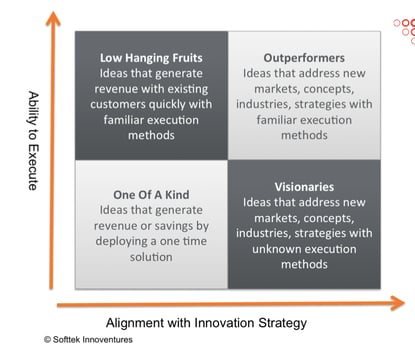
Last year we decided to take some ideas and turn them into products. We engaged the Softtek community and encouraged them to turn in ideas, hundreds and hundreds of ideas.
We looked at some CMO-focused technologies and mobile enterprise apps, and from there we narrowed them down to nine cool ideas that we’re actually in the process of taking to market.
We broke our Innoventures program into four steps:
1. Area of Focus: Strategically aligned with Softtek
We find management friendly solutions. If an idea is management-hostile, management won’t care, and it’s too risky. If it’s management-friendly, management will commit to it.
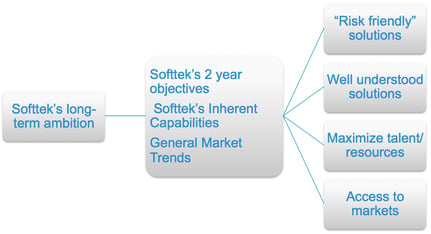
The goal here is to look at the big picture - what is Softtek trying to do in the next ten years? What can we do in the next two years to help Softtek achieve this?
2. Idea Submission: Turn any idea to a business case
The next step is to take an idea from one of our intrapreneurs and help him or her grow as an entrepreneur by turning the idea into a real business plan we can execute.
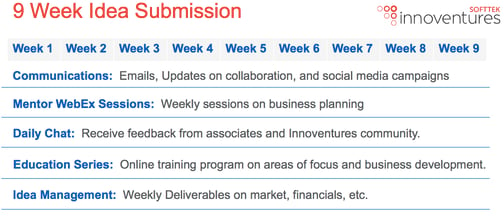
3. Idea Development: Develop and test 9 ideas
Our employees are not entrepreneurs, they’ve never seen a business plan, but they have ideas. So we implemented a deliberate process of taking an idea and making it into a business plan.
We take those business plans, and develop a product we can take to a customer, depending on early successes.
Week one, tell us your idea. Week two, who is your customer? Week three, what’s your target market? Week four, what are your finances? It’s a very systematic way of taking an idea and converting it into a business plan.
4. Idea Launch: Launch three ideas in full gear
We finally launch each initiative.
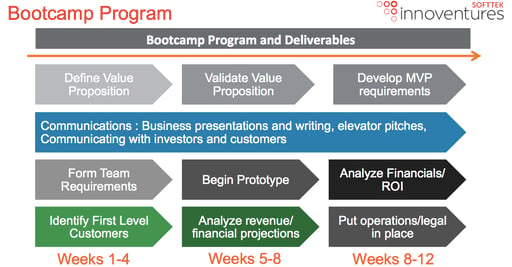
Nine of our intrapreneurs go through our internal boot camp. The focus of the boot camp is to pair each intrapreneur with a mentor. Our mentors, who are top-level executives, work with them directly to take their ideas to fruition.
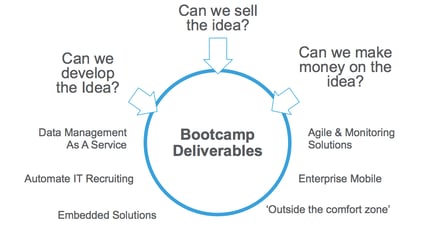
Finally, we will launch three ideas in the areas of agile workflow for development, enterprise mobile apps, and application development. These initiatives are aligned with what Softtek hopes to achieve in the next few years, but nothing earth shattering yet.
Conclusion
There are billions of dollars invested in corporate innovation programs each year, but given their historically dismal success rate, we took a different approach.
We decided to work with small “I” innovations, things that would add significant incremental value to Softtek in the short-run, in the hope of becoming visionaries and outperformers in the long run.
We’re working to build ecosystems within Softtek and with others to form a basis for continuous co-innovation that can be expanded and over a period of time.
That’s the process we’re committed to at Softtek – and it’s a process I believe you can commit to as well.


